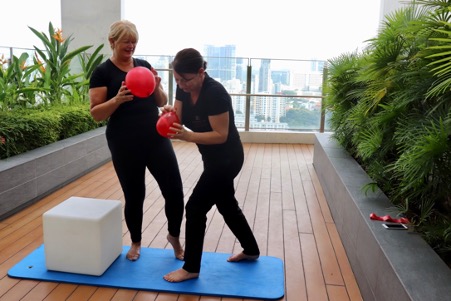BALANCING THE DIAPHRAGMS 6-WEEK PROGRAM

By Julie Hammond & Fiona Palmer
Balancing The Diaphragms 6-Week Program
Dates: Sunday 6th Mar, 13th Mar, 20th Mar, 27th Mar, 3rd Apr, 10th Apr 2022
Time: 3.00pm - 5.30pm AWST
Cost: $750AUD
*Payment Options are available via Go-Cardless - Enquire within: info@anatomytrainsaustralia.com
Tickets can be purchased until Thursday 3rd of March 2022 9.00am AWST.
Balancing The Diaphragms 6-Week Program:
Julie and Fiona both have a passion in Women’s Health and collaboration between health professionals as well as treating Women’s Health problems through a global lens. A pelvic floor problem is more than just a pelvic floor problem. They both have over twenty years of clinical practice experience and combined their thoughts to develop Balancing the Diaphragms.
Balancing the Diaphragms is made up of a series of workshops looking globally at all the diaphragms, then leading into individual workshops on each diaphragm before putting it altogether. After many years in clinical practice, Julie and Fiona noticed how important the relationship was between the diaphragms in the body, and how problems in one diaphragm can affect another. You cannot treat pelvic pain and dysfunction without looking at the ribcage position and breathing patterns. The workshops look at pelvic health, breathing dysfunction and back pain from a more global perspective.
This 6-Week Program will be split into 6 sessions of 2,5-hour modules, held over the course of 6 weeks, taking place each Sunday. Besides the live webinar each week, you will receive the following extras:
- Access to bonus manual techniques
- 12 Months access to recordings
- Bonus movement videos
- Private Facebook group access for networking and discussions
- Relevant research papers to discuss each week
- Guest presenters
- Q&A networking morning online
- Inclusion in a Member Directory to showcase our members
The 6-Week Program format:
- Global View of the Diaphragms - Introduction to the program, our goals, getting to know each other, a global view of the body, defining the diaphragms, experiential, the importance of knowing your clients' starting point.
- Understanding the Pelvis Anatomy - Deep delve into the anatomy, BodyReading pelvis position, strategies, manual techniques, movement and client homework.
- The Arches of the Feet - Amazing anatomy of the feet, adaptability or lack of it - how this can affect the pelvis. Manual and movement techniques. Link to the pelvis.
- The Respiratory Diaphragm and Thoracic Aperture - Deep delve into the anatomy of the respiratory diaphragm, what can go wrong, connections above and below, experiential, anatomy of the thorax and the fascial connections. Hypopressive breathing, unweighting the shoulders, manual techniques and movement.
- The Fascial Neck Cylinders / Floor of the Mouth/ Tentorium Cerebelli - A deep dive into this amazing anatomy, what it means from a treatment point of view, connections above and below, postural compensations, manual and movement techniques.
- Putting it altogether- A case study demo to link the postural patterns and techniques. A movement practice to link the diaphragms for a group class. This module will include a quiz to review the previous 5 modules.
About Julie Hammond:
Julie is director and lead teacher of Anatomy Trains Australia and New Zealand; she has been in the bodywork industry for over twenty years whilst running a busy practice in Western Australia. She is a self-confessed anatomy nerd, with a passion for the pelvic floor, jaw and foot anatomy and dysfunction.
It is through her clinical practice observations that Julie became interested in the link between the diaphragms in the body, and how focusing on a more global approach achieved greater results with her clients. She teamed up with Fiona Palmer, who is a UK Anatomy Trains teacher and Pilates teacher, to develop 'Balancing the Diaphragms'.
Julie contributed a chapter to David Lesondak’s new book ‘Fascia, Function and Medical Applications'. This chapter is based on a Structural Integration case study, on a client who had experienced pelvic floor pain and dysfunction after the birth of her son. Julie is currently studying Human and Medical Science with a strong focus on research.
About Fiona Palmer:
Fiona has been a movement therapist for the last twenty-five years, and bodyworker for more than twenty years. Her client base of rehabilitating after injury, surgery, childbirth has become her passion.
Fiona's background is in clinical Pilates, pelvic floor dysfunction and low back pain. She runs a busy clinic in Clare's small bustling town in Suffolk, and runs an online Pilates and hypopressive breathing and postural exercise business.
Fiona is also one of the Anatomy Trains teachers allowing her to share her passion for anatomy and the body. Seeing some clients for either movement or manual therapy alone and others for a combination gave rise to some questions.
For example, why do some people fair better than others? Is pelvic floor dysfunction about something other than the weakness that most often gets the blame? Does better breathing help back pain and the pelvic floor? A more "wholistic" or global approach seems to offer more significant benefits in the long term. The links between the diaphragms became more interesting when she started introducing hypopressive exercise into her exercise programme.
Fiona teamed up with Julie Hammond, director of Anatomy Trains Australia and New Zealand and together, they have developed Balancing the Diaphragms.




